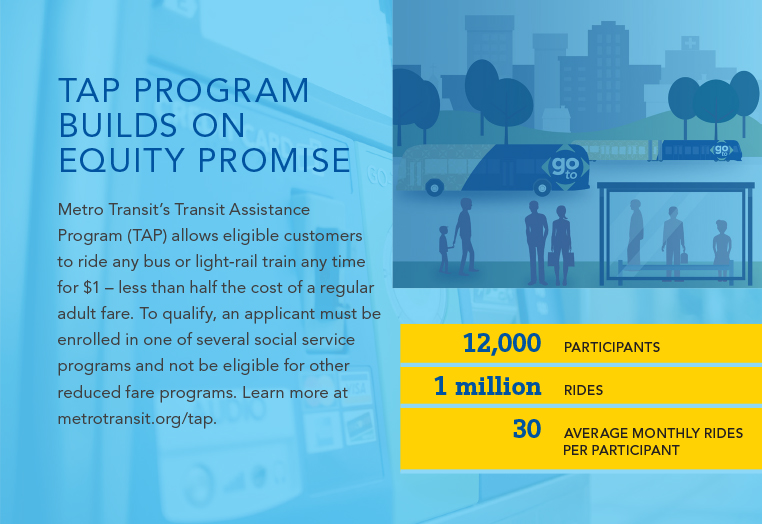Strategy 6 Support efforts to ensure transit is a safe, comfortable and affordable option for all city residents.
The actions within this strategy are divided into two categories:
Action we will DOActions we will SUPPORTAction we will do are followed by “DO” and are colored in dark gray, and actions we will support are followed by “SUPPORT” and are colored in light gray.
Learn more about how we get thereWe heard through our engagement that free transit fares, lower transit fares or more affordable transit was a desire for most people as current transit fares were considered a barrier for many individuals.
Transit fares (local bus and METRO/light rail) on Metro Transit currently are $2.50 for rush hour rides (6:00-9:00 am and 3:00-6:30 pm Monday – Friday) and $2.00 for non-rush hour rides. Reduced fares of $1.00 are available for low-income individuals with valid documentation, seniors (65+), youth (6-12) and Medicare card holders during non-rush hours; express bus rides cost more. Express bus rides are more. People with disabilities with valid documentation can ride the system (local bus, METRO and express bus) for $1.00 at any time with the Transit Assistance Pass (TAP card). Metro Transit also has a partnership with Minneapolis Public Schools which offers Go To Cards to high school students who take the city bus to school for $97/quarter.1
There is currently one example of a zone discount and two examples of free fares within the Metro Transit system:
- The downtown zone has a $0.50 fare for rides within an established zone.
- Free rides between the Minneapolis Convention Center and the METRO Blue and Green lines on 5th Street in downtown Minneapolis via the Route 18, 10 or 59 along Nicollet Mall. This service is available 7 days a week between 5:00 am and 1:00 am.
Additionally, there are several times throughout the year that Metro Transit offers free rides, in partnership with others, to encourage safe travel behaviors. These days typically include afternoon/evening/night of St Patrick’s Day, New Year’s Eve, and other days on occasion.
Feeling safe while riding or waiting for transit was another key theme we heard during engagement. There are many elements that contribute to real and perceived safety conditions at station locations and on transit vehicles – including the presence or lack of presence of other riders, lighting, security cameras, access to emergency phones, the cleanliness of vehicles and waiting areas, and the conduct of fellow passengers or other people on the vehicle or at or near a stop. Special considerations during winter – like clear and passable paths from stations to vehicles for all users and at waiting areas are also important to make transit safe and comfortable.
- Metro Transit. https://www.metrotransit.org/student-pass-admin.
Actions to support efforts to ensure transit is a safe, comfortable and affordable option for all city residents.
Transit 6.1
Study and assess the feasibility of free or reduced transit fares; evaluate the passage of programs citywide and/or within certain zones or based on trip distance.
Supported goals:
Equity Mobility Active Partnerships
Related actions:
Difficulty:
High
Timeframe:
2024-2027 (Years 4-7)
Transit 6.2
Establish requirements for monthly transit pass participation for all new commercial, mixed-use and residential buildings within a half mile of a high frequency transit corridor.
Supported goals:
Climate Mobility Active Partnerships
Related actions:
Difficulty:
High
Timeframe:
2020-2023 (Years 0-3)
Transit 6.3
Support Metro Transit initiatives tied to increased security of the transit system that address real and perceived safety issues while considering equity concerns.
Supported goals:
Safety Equity Active Partnerships
Related actions:
Difficulty:
Low
Timeframe:
2020-2023 (Years 0-3)
Status:
On-going
Transit 6.4
Work with partner agencies to improve customer comfort through clean waiting areas and upgraded amenities such as shelters, lighting, seating, heat and real-time schedule information.
Supported goals:
Safety Equity Mobility Active Partnerships
Related actions:
Technology 3.1
Difficulty:
Medium
Timeframe:
2020-2023 (Years 0-3)
Status:
On-going
Transit 6.5
Work with Metro Transit to expand affordable fare programs and increase participation among eligible residents.
Supported goals:
Equity Mobility Active Partnerships
Related actions:
Difficulty:
High
Timeframe:
2020-2023 (Years 0-3)
Status:
On-going
Transit 6.6
Support Metro Transit’s work with Minneapolis Public Schools and other non-profit organizations to provide affordable fares for all program participants.
Supported goals:
Equity Mobility Active Partnerships
Related actions:
Difficulty:
Low
Timeframe:
2020-2023 (Years 0-3)
Status:
On-going
Transit 6.7
Work with Metro Transit to expand fare-free days throughout the year and fare-free routes in the city.
Supported goals:
Equity Mobility Active Partnerships
Related actions:
Transit 1.9
Difficulty:
Medium
Timeframe:
2020-2023 (Years 0-3)
Status:
On-going
Transit 6.8
Encourage investment and design of integrated design elements to engage people and reflect the communities that transit serves through signage/wayfinding, public art, plaza/open spaces, streetscape, and real-time traffic count displays, and other creative or interactive design elements on major transit projects (light rail, bus rapid transit, etc.)
Supported goals:
Equity Prosperity Active Partnerships
Related actions:
Design 5.1, Design 5.2, Design 5.3
Difficulty:
Medium
Timeframe:
2020-2023 (Years 0-3)
Status:
On-going
Transit 6.9
Support partner agency efforts to work with new immigrant and non-English speaking communities to educate and build familiarity with the transit system for prospective riders.
Supported goals:
Equity Mobility Active Partnerships
Related actions:
Difficulty:
Medium
Timeframe:
2020-2023 (Years 0-3)
Status:
On-going
See also actions:
- Walking 4.3
Winter maintenance at transit stops and stations - Technology 3.3
Integrated payment technology


